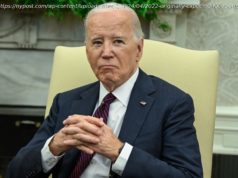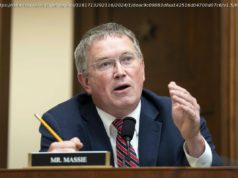Soybean growers are particularly vulnerable to a small drop in exports.
China’s latest trade actions in response to U. S. tariffs are striking right at the heart of Trump country.
Just the mere mention of the threat to slap tariffs on key U. S. exports threatens to further upend a farm economy already suffering from low prices. It also risks further alienating an important base that has long been frustrated with the administration’s trade policies.
U. S. farmers preparing to plant soybeans this season are now facing the prospect of losing money on their crops before they put their seeds in the ground, after China announced on Wednesday that it would retaliate with 25 percent tariffs on dozens of farm products if the U. S. carries through with its 25 percent levy on Chinese imports.
Trump administration officials have dismissed concerns about harm to the American economy from the escalating tit-for-tat trade war, but farming communities are already feeling the effects.
“The governments have the ability to be irrational in rhetoric and in deed longer than a single farmer has the ability to remain solvent,” said Brent Bible, a soybean and corn farmer in central Indiana. “Does it take a year? Does it take two years to finally come to some equilibrium? That’s a long time for the typical farmer to have to sit and wait for prices to become profitable.”
The Chinese market is especially crucial to American soybean farmers. The United States exported nearly $14 billion worth of soybeans to China in 2017, representing nearly 30 percent of the nation’s soybean production.
Futures prices for soybeans dipped between 4 and 5 percent at the beginning of the day on Wednesday in response to China’s threat. Farmers said they don’t predict any major long-term market improvements amid all the trade uncertainty. China listed more than 100 items that would face the tariffs if instituted; by value, soybeans would be the most significant product on China’s list.
“The anticipation of what is to come is really what’s driving those prices down today and probably for the foreseeable future,” Bible said.
The USDA’s crop forecast for soybeans released last week predicted slightly less acres being planted. That drove prices a little higher last week, giving farmers some hope of better returns come harvest time. But with China’s tariffs now more of a reality, that hope has all but diminished.
“As well as trying to outsmart the weather and bugs and weeds, now you gotta outsmart our president and you gotta outsmart the markets based on what the president is doing,” said John Kiefner, an Illinois farmer who grows soybeans about 50 miles southwest of Chicago.
Kiefner said his closeness to a major city gives him some flexibility to change some of his crops — he may plant more hay and pumpkins to blunt any possible drop in sales from soybean tariffs. But most farmers are already past the point of no return when it comes to planning for their 2018 crop.
“I think most farmers kind of have their hands tied,” he said. “You’ve gotta plunge into it with blind faith that this will get resolved. If you’ve already bought seeds, you’ve already rented acres, there aren’t many options.”
Most experts agree that China‘s current and growing demand for the legume will make it impossible for that nation to source its needs domestically. Soybeans are a vital feed ingredient to the country’s massive pork industry and the seeds are crushed into oil for human consumption.
Brazil is viewed as an alternative source for China and an expected bumper crop that’s being harvested now in the South American country could provide some short-term relief if Beijing went ahead with tariffs. Still, China has proven to be resourceful in how it manipulates markets and could find ways to subvert the need for U. S. soybeans, said Bible, the Indiana farmer.
“It would be a mistake for our government or our industry to think we are irreplaceable in terms of the supply of soybeans,” he said. “That’s a dangerous place to get into.”
Chinese Deputy Finance Minister Zhu Guangyao said as much during a press conference. Zhu said that the amount of soybeans that the nation imported from the U. S. was too large.
“U. S. government subsidies have affected the cultivation of soybeans in China,” Zhu said.
For many farmers real money is on the line, even if prices fluctuate by a seemingly moderate amount.
“We’ve been kind of struggling the past four years as far as making a living, we’re near that break even point as prices go already,” said Kevin Scott, a soybean and corn farmer in southeast South Dakota.
He said he would take a $40,000 hit if soybeans lose 10 percent off the current market price, which he said is easily conceivable given how big of a market China is for U. S. soybeans.
Agriculture Secretary Sonny Perdue tried to offer some reassurance during a tour on Wednesday through Ohio.
“I talked to the president as recently as last night,” Perdue told reporters. “And he said, ‘Sonny, you can assure your farmers out there that we’re not going to allow them to be the casualties if this trade dispute escalates. We’re going to take care of our American farmers. You can tell them that directly.'”
Kirk Liefer, a soybean farmer in southern Illinois, said he is holding out some hope that China might not actually proceed with the tariffs, but he indicated that patience over the administration’s trade policy is wearing thin in rural areas.
“As he has stepped into office we have had withdrawal from the TPP, renegotiation of the NAFTA agreement and we sit here today with these possible tariffs,” he said. “I think we need to take a step back and probably say, ‘Hey, look who got you into office, when are you going to step up and support us?‘”
Liefer, who runs an operation with his parents and two younger brothers said about half his 2018 crop is already locked down in contracts, but tariffs would still hurt his business. However, he indicated that he was still open to giving Trump the benefit of the doubt.






